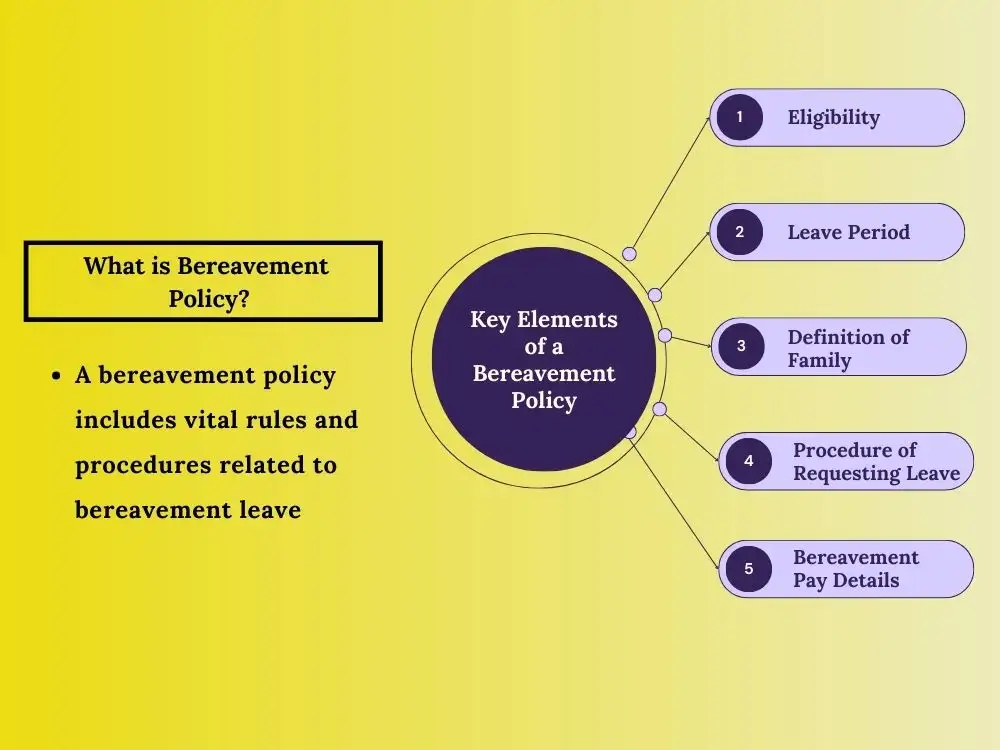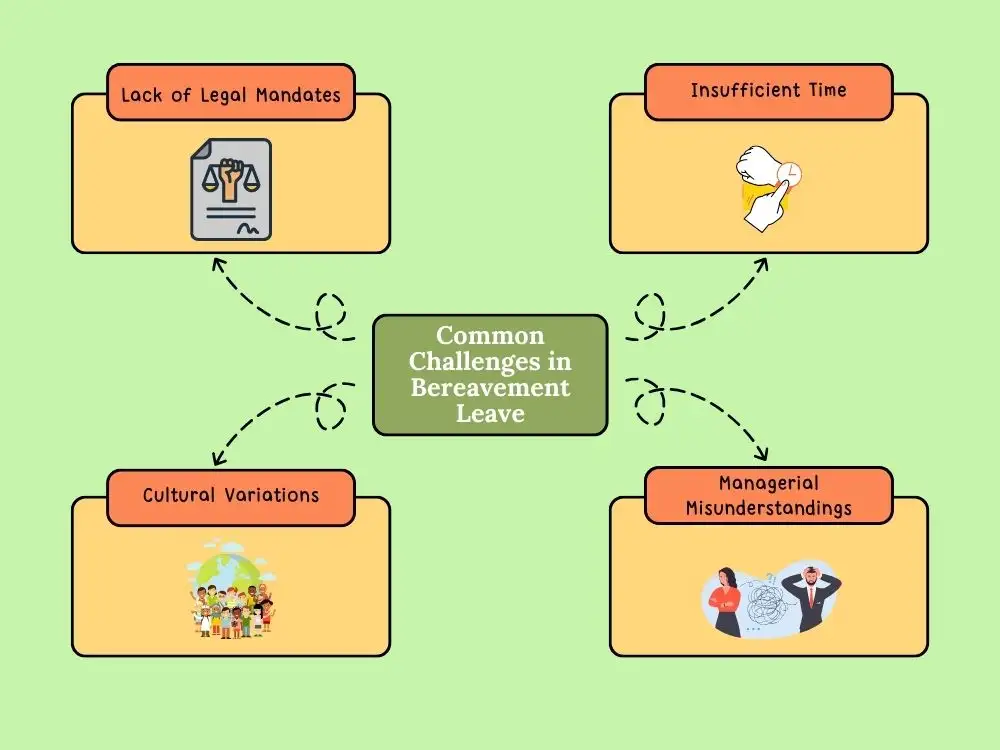
What is Bereavement Leave? What Every Employee Should Know?
Losing someone you care about is really tough. When people go through this kind of situation, they often need some time off from work to grieve, go to funerals, or handle family stuff. This is where companies offer bereavement leave for their employees when they face such personal loss.
In this article, we will discuss:
- What bereavement leave means, its importance for employees, and laws related to it.
- Understand bereavement pay and how it works.
- Learn about bereavement policy and its key elements.
- Method to request bereavement leave (with a downloadable example), common challenges, and the benefits of utilizing AI tools.
What is Bereavement Leave?
It is also known as funeral leave which is provided to employees when one of their loved ones dies. It is a kind of leave that allows employees to take time off to grieve and attend memorial processes or make arrangements following the death.
Unlike sick leaves or holiday leaves, bereavement leaves are hard to plan before the occurrence. It happens suddenly at a very emotional phase for the employee.
Bereavement Leave Laws
The legal framework for bereavement leaves varies widely with no universal mandates in many countries. Here are some key points to know:
- Federal Law in the US: According to this law, employers aren't federally required to offer bereavement leave. It is the individual companies' decision whether to offer this benefit or not.
- State Regulations: Specific requirements have been enacted by certain states. California Family Rights Act (CFRA) states that bereavement leave shall not be less than five days for eligible employees for the death of a family member.
- Union and Contract Provisions: Bereavement leave is negotiated through collective agreements in unionized workplaces. These could be clear and structured benefits for workers.
- Public Sector Benefits: As with many other benefits, many public sector workers have bereavement leave with a structuring aspect.
While bereavement leave isn't mandated by law, employers prefer providing them to support their employees during difficult times. Additionally, employers take part in workers' grief by sending condolence messages which helps console them a little bit.
Understanding Bereavement Pay
Bereavement pay is the amount paid to an employee during the bereavement leave period. However, not all organizations pay for this type of leave.
How Bereavement Pay Works?
- Full pay: Some companies provide employees totally paid benefits for the bereavement period as continuity payments.
- Unpaid Leave: Some companies allow time off but don’t provide any compensation during this period.
- Partial Pay: In this type, employees may receive reduced pay during bereavement leave.
Depending on the company's policy and the labor laws of the country, there can be significant variation in the availability of bereavement pay.
What is a Bereavement Policy?

A bereavement policy includes vital rules and procedures related to bereavement leave. This policy clarifies both employees and employers regarding the implications. Plus, it greatly reduces misunderstandings at emotionally sensitive times.
Key Elements of a Bereavement Policy
- Eligibility: This specifies the eligible employees for bereavement leave. For example, (full-time employees, part-time employees, or contract employees).
- Leave Period: This part explains how many days you can take off for bereavement. For instance, you get about 3 to 5 days for close family, and 1 to 2 business days if it’s for extended family (Please note that the number of days may be higher in some companies. It depends on the policy).
- Definition of Family: This clarifies the difference between immediate or extended family members. For example, spouse, parent, or sibling as an immediate family member. Aunt, cousin, or grandparents as an extended family member.
- Procedure of Requesting Leave: This defines how the employee notifies the employer and what sort of documentation needs to be provided.
- Bereavement Pay Details: This part shows whether the leave is paid or unpaid.
A good bereavement policy is necessary to support employees during their loss. Plus, it promotes a compassionate workplace culture.
Bereavement Leave Around the World
The bereavement leave policies vary significantly across countries. The table below shows this comparison in a snapshot:
Country |
Bereavement Leave Policy |
|---|---|
| United States | No federal mandate where policies vary by company or state (Ex: Oregon mandates leave). |
| United Kingdom | Up to 2 weeks for child loss. Other bereavement leave is decided by the employer. |
| Canada | Up to 10 days leave if an employee loses an immediate family member. Some provinces mandate pay for part of the period. |
| Australia | 2 days paid leave per occasion for immediate family members. |
| India | No statutory requirement. It is highly dependent on company policies. |
How to Request Bereavement Leave?
In the unfortunate event of a loss, here are some things that you should do immediately to request bereavement leave:
- Notify Your Employer Promptly: As soon as something happens, immediately notify the manager/HR. Even if it's just a bit of a vague detail, you should call or send an SMS to give your manager the news.
- Follow Company Policy: Follow your normal company process for requesting leave, whether it is a verbal or written communication.
- Provide Necessary Documentation: This is not entirely needed in this type of leave request. However, if required submit any proof for validation.
- Communicate Your Needs: Clearly state how much time you need. Also, mention if you need additional leave beyond the bereavement period.
Find this example of a bereavement leave request:
Common Challenges in Bereavement Leave
Even though it is important for employees, it also comes with certain challenges. Let's find out:

- Lack of Legal Mandates: So many countries and companies don't mandate bereavement leave. This may leave employees ambiguous about their rights.
- Insufficient Time: Most of the time, employees feel that the given time for leave is inadequate. This is highly related when travel is required.
- Cultural Variations: Different cultures may require varying mourning periods. This makes one-size-fits-all policies challenging.
- Managerial Misunderstandings: Some managers may lack empathy or lack understanding of the grieving process. This leads to pressure on employees to return to work prematurely.
How AI Tools Help Manage Bereavement Leave
Technology plays a significant role in simplifying bereavement leave management for both employees and HR departments. Here, AI tools are highly useful and can streamline processes with helpful resources.
- HR Management Software: Software tools like BambooHR or Gusto help streamline the leave application process. They allow employees to submit requests digitally while enabling HR to manage and track leave policies efficiently.
- Calendar Integration Tools: Using Google Calendar or Outlook, employees and HR teams can schedule bereavement leave dates, coordinate tasks, and ensure smooth transitions for any work handovers during the leave period.
In addition to these tools, you can also use our Time Converter for global organizations. This tool helps employees coordinate across time zones for funeral arrangements or communicate with HR teams in different regions.
Wrapping Up
Bereavement leave is significant because it enables employees to have the space and time to take care of their well-being in difficult times. Every employee should understand bereavement leave, bereavement pay, and workplace policies. This helps them empower and navigate this period with less stress.
Employers who have compassionate bereavement policies demonstrate their commitment to employee well-being. This particular thing enhances employee engagement, trust, and loyalty within their teams.
Additionally, by leveraging the power of AI tools, companies can further enhance their support systems. This ensures a better and more empathetic process for everyone involved.
FAQs
Q1: Can I use sick leave instead of bereavement leave?
Some companies will accept sick leave for bereavement when they have no specific policy for it. Check first with your HR department or manager for options.
Q2: Can I extend my bereavement leave if needed?
Yes, most of the time employers understand and extend your leave as needed. Just share your situation and provide any necessary documents.
Q3: What to do if my company doesn't offer bereavement leave?
You can have a chat with your manager and request to take unpaid leave or use your personal or vacation days.
Explore Related Posts
https://smarttoolsai.com/post/short-condolence-message
https://smarttoolsai.com/post/1st-2nd-3rd-shift-hours
https://smarttoolsai.com/post/2-2-3-schedule-or-panama-schedule
.webp)